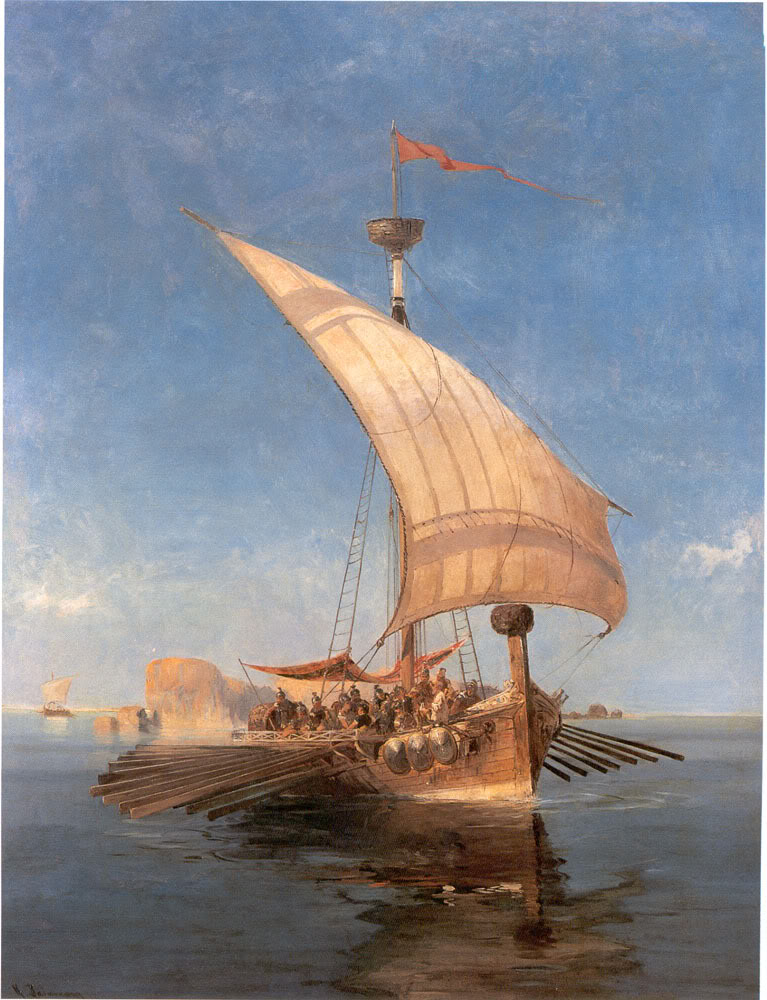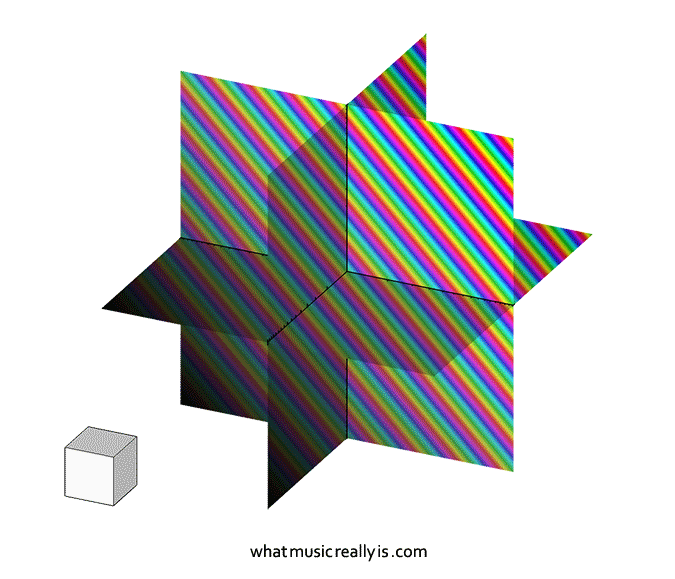

The ship wherein Theseus and the youth of Athens returned from Crete had thirty oars, and was preserved by the Athenians down even to the time of Demetrius Phalereus, for they took away the old planks as they decayed, putting in new and stronger timber in their places, insomuch that this ship became a standing example among the philosophers, for the logical question of things that grow; one side holding that the ship remained the same, and the other contending that it was not the same.
— Plutarch, Theseus

The Euclidean algorithm (which comes down to us from Euclid’s Elements) computes the greatest common divisor of two given integers. It is shown here that the structure of the Euclidean algorithm may be used to generate, very efficiently , a large family of rhythms used as timelines (ostinatos), in sub-Saharan African music in particular, and world music in general. These rhythms, here dubbed Euclidean rhythms, have the property that their onset patterns are distributed as evenly as possible. Euclidean rhythms also find application in nuclear physics accelerators and in computer science, and are closely related to several families of words and sequences of interest in the study of the combinatorics of words, such as Euclidean strings, to which the Euclidean rhythms are compared.
The “Research” section on this website represents the in-the-making process of the What Music Really İs manual as an interactive presentation, book, and featured documentary. It wishes to be the scientific & mystical knowledge base on the science of music: harmonics, sound, acoustics, tuning and all else related.
“What Music Really İs” is a statement. It is not a question, and not a theory. It is a fact. “What Music Really İs: The Manual for The 3rd Millennium Musician, Spiritual Seeker and Free Energy Discoverer” together with “Harmonic Series Hearing Study for the Liberated Ear”: the only True Ear Training lessons for the development of Perfect Aural Frequency and Harmonic Sonic Distance Recognition are currently the single resources that present music for what it really is, without points of view or centers of interest.
All the concepts presented here are not the result of historical practice, do not adhere to any philosophy, are not linked to any school of taught and do not specifically endorse any form of institutionalized, academic- or esoteric-type of content. The form in which all facts are presented does not make use of any standard (modern or ancient) music theory or nomenclature.

Why are some ideas, processes and products (or, memes) popular, and others not? And - What is the unit of culture? For that matter: What is `Culture'? This short book synthesizes the Systems Model of Creativity (Csikszentmihalyi 1988, 2014) and Evolutionary Epistemology (Campbell 1974) to explain why some things are popular, and defines and describes the structure of the Meme, the unit of culture (Dawkins 1976).
« Claude Levi-Strauss : les artistes bricoleurs se retrouvent face à ensemble d’objets hétéroclites qu’ils interrogent pour comprendre et imaginer ce que chacun d’eux pourrait signifier. Chaque élément représente un ensemble de relations à la fois concrètes et virtuelles, ce sont des opérateurs. La particularité de ces objets est qu’ils ont déjà servis et les possibilités de leur ré-emploi demeurent toujours limitées par ce qui subsiste en eux de cette histoire passée. Leur usage originel fait d’eux des éléments pré-contraints et ouvrés ; ils ont donc été travaillés par un précédent auteur qui leur a attribué une signification précise et soumise à l’œuvre qu’il réalisait. Le second auteur s’affairera ainsi à démonter cet ensemble de signification afin d’en créer de nouvelles. Yann Beauvais et J-M Bouhour confirment, les deux lois fondamentales de détournement sont : - la perte d’importance allant jusqu’à la déperdition du sens premier de chaque élément autonome détourné, et en même temps - l’organisation d’un nouvel ensemble signifiant qui confère à chaque élément sa nouvelle portée. »
Quote from http://www.openculture.com/2013/09/william-s-burroughs-explains-what-artists-creative-thinkers-do-for-humanity.html
The interview clip above, from the 1991 documentary Commissioner of Sewers, puts a two-part question to Naked Lunch author, “cut-up writing” master, and counterculture eminence William S. Burroughs: “What is the original feel of the writer? What mechanisms should he consider, work on?” That may sound like a slightly odd line of inquiry — the interviewer, bear in mind, doesn’t speak English natively — but Burroughs responds with an important point, clearly made. “The word should should never arise,” he first insists, though perhaps self-contradictorily. “There is no such concept as should in regard to art — or anything — unless you specify. If you’re trying to build a bridge, then you can say we should do this and we should do that, with respect to getting a bridge built, but it doesn’t float in a vacuum.” All well and good for engineering. But what can art do, if not build a bridge?
“One very important aspect of art is that it makes people aware of what they know and what they don’t know that they know,” Burroughs says. “This applies to all creative thinking. For example, people on the sea coast in the middle ages knew the Earth was round. They believed the Earth was flat because the church said so. Galileo tells them the Earth was round, and nearly was burned at the stake for saying so.” Burroughs summons as examples Cézanne, whose studies of what “objects look like seen from a certain angle and in a certain light” at first made viewers think “he’d thrown paint on canvas,” and Joyce, who “made people aware of their stream of consciousness, at least on a verbal level,” but “was first accused of being unintelligible.” Yet Burroughs found he lived in a world where, this art already having expanded humanity’s consciousness, “no child would have any difficulty in seeing a Cézanne” and few “would have any difficulty with Ulysses. The artist, then, expands awareness. Once the breakthrough is made, this becomes part of the general awareness.” Such insight makes Burroughs, as one Youtube commenter puts it, “so down-to-earth that he’s far-out.”
Commercially available conductive fabrics are mostly evenly coated basic woven and knit structures. There is nothing fancy, distinct or particularity interesting about their aesthetic appeal. They are metallic, shiny and uniform. What if you could weave your own conductive fabrics. For one you could tailor the electrical properties of the fabric to your own designs, and for another you could add colour, texture, patterns and aesthetic qualities to the material. This post goes over an example of weaving your own conductive fabric to incorporate some of these elements.
Music Theory for Musicians and Normal People by Toby W. Rush
This collection is a work in progress, but if you would prefer, you can download all the current pages as a single PDF.
One of our most innovative, popular thinkers takes on-in exhilarating style-one of our key questions: Where do good ideas come from?
With Where Good Ideas Come From, Steven Johnson pairs the insight of his bestselling Everything Bad Is Good for You and the dazzling erudition of The Ghost Map and The Invention of Air to address an urgent and universal question: What sparks the flash of brilliance? How does groundbreaking innovation happen? Answering in his infectious, culturally omnivorous style, using his fluency in fields from neurobiology to popular culture, Johnson provides the complete, exciting, and encouraging story of how we generate the ideas that push our careers, our lives, our society, and our culture forward.
Beginning with Charles Darwin's first encounter with the teeming ecosystem of the coral reef and drawing connections to the intellectual hyperproductivity of modern megacities and to the instant success of YouTube, Johnson shows us that the question we need to ask is, What kind of environment fosters the development of good ideas? His answers are never less than revelatory, convincing, and inspiring as Johnson identifies the seven key principles to the genesis of such ideas, and traces them across time and disciplines.
Most exhilarating is Johnson's conclusion that with today's tools and environment, radical innovation is extraordinarily accessible to those who know how to cultivate it. Where Good Ideas Come From is essential reading for anyone who wants to know how to come up with tomorrow's great idea
Mobile is a French-American bilingual magazine, where a part of creation meets a part of reflection.
The Peters Projection World Map is one of the most stimulating, and controversial, images of the world. This map was first introduced by historian and cartographer Dr. Arno Peters at a Press Conference in Germany in 1974.

The concept of multiple discovery is the hypothesis that most scientific discoveries and inventions are made independently and more or less simultaneously by multiple scientists and inventors.
Sur cette page vous pouvez accéder à une cinquantaine de séances Ars Industrialis indexées sous "Lignes de Temps".
A selection of links about generative and new media art by Marius Watz
Geoffrey West est physicien et travaille depuis quelques années sur le thème de la ville à l’Institut de Santa Fé. L’objectif de West : découvrir les lois cachées qui régissent l’organisation urbaine.
Le séminaire "poésie:numérique" se propose d'élaborer, à partir du questionnement des oeuvres, un mode d'approche analytique de la poésie créée avec l'ordinateur.
Written for the catalogue to accompany the exhibition Star dot Star at Site Gallery, Sheffield, and the symposium Dialolgues with the Machine held at the ICA in 1998
For several years now, I've been using the simplest system of all - the binary system - instead of the decimal one, in other words, progression two by two because I've found that it helps perfect the science of numbers.
Le Septieme art est une expression proposee en 1912 par Ricciotto Canudo pour designer l' art cinematographique ...
Art21 is a nonprofit organization founded in 1997 with the mission to increase knowledge of contemporary art, ignite discussion, and inspire creative thinking by presenting artists at work and in their own words.
Stop the projector! Time for a little analysis.
En aquesta unitat es preten proporcionar un coneixement general sobre totes aquelles practiques artistiques que utilitzen la llum o imatges luminiques com a mitja de creacio. S'inicien les activitats fent una introduccio sobre
Arts des nouveaux medias [AdNMblog] est un blog de documentation et d analyse dedie aux implications des nouveaux medias dans l art contemporain. Il est publie par Jean-Louis Boissier, professeur a l Universite Paris 8.
Philosophie, sociologie, psychanalyse, cinema, musique, arts plastiques, mais aussi photographie, pornographie...
by Ken Feingold
This essay sets out the concept of engrammation which deals with the process of text mediatization and presents some practical examples such as different algorithmic programming in order to illustrate the mediatization processes.
The aim of this website (begun May 2007) is to provide a space for critical texts on contemporary art that, as they accumulate, will cover as broad a spectrum as possible in terms of media and themes.
-empyre- facilitates critical perspectives on contemporary cross-disciplinary issues, practices and events in networked media by inviting guests -key new media artists, curators, theorists, producers and others to participate in thematic discussions.
The mid-1960s saw many artists becoming interested in the creative activities at the confluence of art and technology. Previously, most individuals involved in the creation of computer art were in fact engineers and scientists...
code flow is a collective engaging contemporary media art and theory through cultural practices that resist the market-driven orientation and the permanence of today's institutions.
Transforming Mirrors : Subjectivity and Control in Interactive Media. An article written for the book "Critical Issues in Interactive Media", edited by Simon Penny, available from SUNY press.